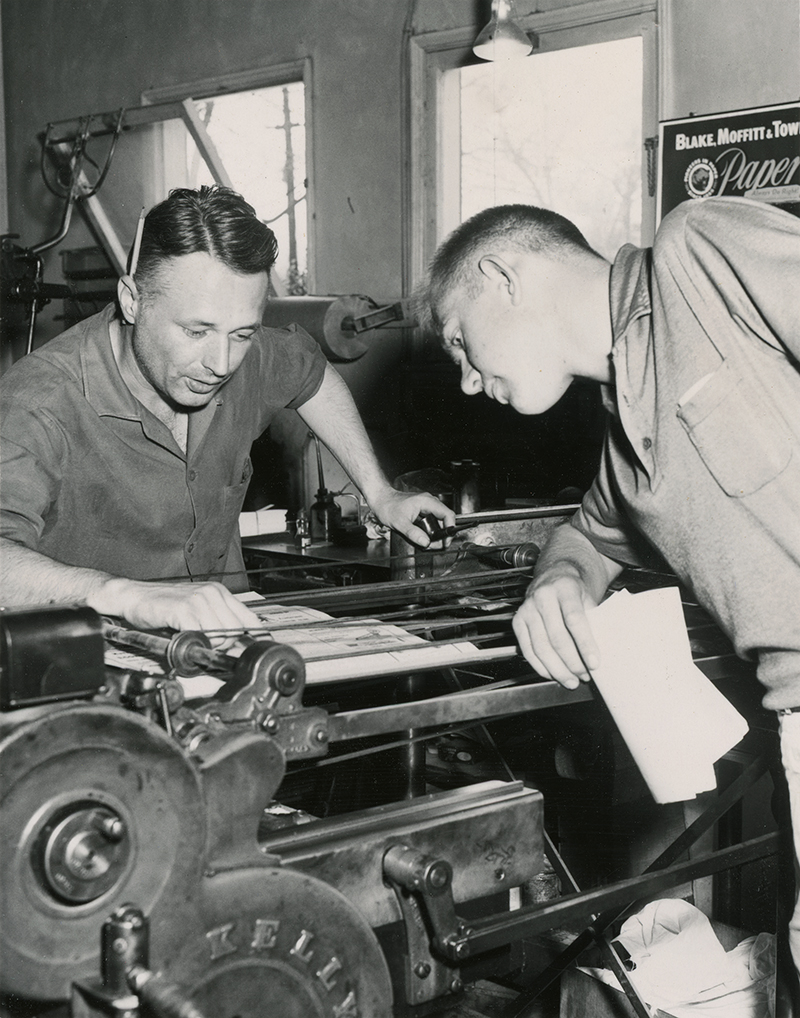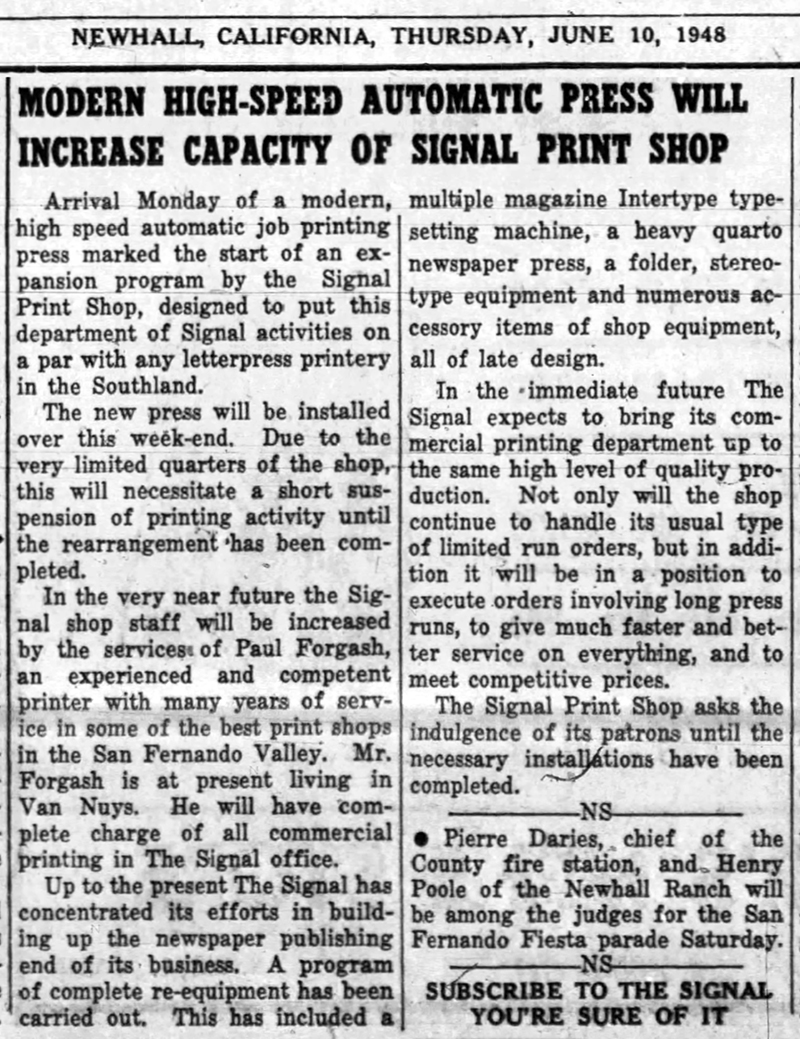Fred Trueblood II, The Signal Print Shop
Newhall, California

Click image to enlarge
| Download archival scan
Press operator Fred Trueblood II (left) and an unidentified assistant stand over a Kelly printing press in the print shop of The Signal newspaper building at 104 W. 6th Street (aka 22504 W. 6th). Undated photograph, probably 1950s. Trueblood's father, Fred Trueblood Sr., bought the paper in 1938 and ran it until his death in 1960, after which Fred II took the helm.
The Signal Presses. When The Signal started in 1919, the paper was located in a rented space at 636 Spruce Street — east side of Spruce (today's Main Street), midblock between 6th and Market streets, next door to the old post office. Founder Edward H. Brown and then his widow Blanche B. Brown printed the paper on a Gordon press, which was the industry standard for small print jobs. According to a later story by Fred Trueblood Sr. (The Signal, March 29, 1951), the paper in 1919
was five columns wide, 12 inches deep and had four pages. There weren't many copies, so it could be struck off, one page at a time, on the Gordon jobber, pumped with a foot treadle. For five or six years that Gordon job press printed the tabloid Signal — until Dad Thatcher became publisher [1925] and got hold of an old Chicago stop cylinder flatbed press. The Signal continued to use the Gordon press for small contract print jobs until it got too rickety. Trueblood, who bought the paper from Blanche Brown in 1938, farmed out the Gordon press in the 1940s to Ernie Hickson's Placeritos Ranch (later known as Melody Ranch) where it was still adequate for Hickson to print "Wanted: Dead or Alive" posters and similar things for use in the movies (ibid.).
In those days, Signal owners couldn't survive solely on the revenues from a few hundred copies of the paper for a community of a few thousand souls. They made ends meet with contract print jobs. In the mid-1940s, Trueblood upgraded the newspaper side of the business with a heavy Babcock quarto newspaper press, a multiple magazine Intertype typesetting machine (commonly known as a Linotype machine) and other modern shop equipment. On the commercial printing side, June 1948 marked the arrival of a high-speed automatic job printing press which would put the Signal "in a position to execute orders involving long press runs, to give much faster and better service on everything, and to meet competitive prices" (The Signal, June 10, 1948). This job press might have been the Kelly, seen here; we can't be certain because the brand isn't named in the story. No longer desirous of renting office and shop space, Trueblood in 1951 bought property and ordered up construction of a new building at the southwest corner of 6th Street and Railroad Avenue. The new address was 104 W. Sixth. He retained a small, corrugated-iron shop building that already stood on the property (The Signal, April 12, 1951) and erected a new, wood-frame and stucco building right next to a tree stump that was "all that remains of one of the trees which Henry Newhall planted in his first park, along the railroad track, more than 80 years ago" (The Signal, July 26, 1951). The week of June 1, 1951, Trueblood hired a heavy-equipment moving company from Los Angeles to relocate the 8-ton newspaper press and No. 5 Linotype machine and other equipment from 636 Spruce Street — the only address the paper had known since 1919 — to the new home a block-and-a-half away (The Signal, June 7, 1951). (The Linotype machine has been preserved as a historical artifact today.) Dial up the clock to the spring of 1963. Twenty-five years of Trueblood ownership ended when Fred II and his brother Richard S. "Gus" Trueblood sold the paper to Ray Brooks, a veteran newspaperman who owned the Sunland-Tujunga Record-Ledger. The Trueblood family continued to own the building (which had been renumbered 22504 W. 6th Street). Brooks rented the property and owned The Signal just long enough to get rid of the Babcock printing press, which he sold and shipped by rail to a newspaper in Sonora, Mexico. Brooks printed The Signal in Tujunga on his new, 16-page, 4-color Thatcher offset press (The Signal, May 2 and June 6, 1963), which was used to add spot color, notably teal on the masthead. Enter the Newhalls. Later that same year (1963), Scott Newhall, then Executive Editor of the San Francisco Chronicle, came to town and offered to buy the Newhall Signal from Ray Brooks. According to son Tony Newhall (pers. comm. 2019):
Brooks said OK, provided Scott also bought the Tujunga Record-Ledger as a package deal. Scott reluctantly agreed, but after a year, after Scott learned that the Record-Ledger was not making enough money to keep both papers afloat, as Brooks had described, Scott got Brooks to take back the Record-Ledger at a discounted price, and Scott retained The Signal, while still having it printed in Tujunga. So, in the fall of 1963, Scott and Ruth Newhall took over publishing The Signal. The premises were unchanged — located on two adjacent parcels (owned by two different landlords) on the south side of Sixth Street at Railroad Avenue. The L-shaped Trueblood building (22504 W. 6th Street) on the east no longer had a printing press. It housed the newspaper's bookkeeping office, display advertising sales, the composing room (where the stories were typeset and pasted on the pages), plus the darkroom, the circulation department and mailroom. The Trueblood building was connected to the Perkins buildings next door to the west by an eight-foot passageway. The Perkins buildings, colloquially known as the "red Signal buildings," which still stand at 22508 W. 6th Street, were owned by historian A.B. Perkins. These buildings housed the newspaper front office plus the editorial department (editors, reporters) and the general manager and publisher's office. On January 4, 1969, a short-circuit in the rear darkroom started a fire and the Trueblood building burned down. [Read what the Newhalls did about it here.] Afterward, the Newhalls expanded the operation to the north side of 6th Street, leasing a house across the street for the circulation office. (This house was said to have been the community's initial Sheriff's station.) The display advertising staff and the production offices moved across town to a building on Spruce Street between 10th and 11th street, just south of the American Theater. [The building housed a rival newspaper which shut down at this time.] In 1973, the L.A. County Sheriff's Department moved its Newhall substation from downtown Newhall to the new County Civic Center at Magic Mountain Parkway and Valencia Boulevard. The former sheriff's substation building at 6th and San Fernando Road [previously Spruce, now Main Street] in Newhall was taken over by The Signal, which gutted the premises and moved in its display ad sales department and composing room. The jail cell in the rear became the Signal's darkroom. By this time, The Trueblood family had rebuilt their building at 22504 W. 6th Street and found a new tenant with Bob and Judi Martin's Auto Parts store. In the late 1970s, the auto parts store vacated. When Morris Newspaper Corp. took over the paper (which remained under Newhall family management), The Signal's ad sales staff and storage moved back into the Trueblood building, which The Signal started using again. For 23 years, from 1963 to 1986, The Signal was printed "out of town." In the latter year, Morris installed an enormous, gently used 10-unit Goss Urbanite press for both newspaper and contract print jobs in The Signal's new headquarters at 24000 Creekside Road in Valencia. It was also the first time in 23 years that The Signal owned its own premises. Postscript. The "Linotype" machine that was on display in the Signal office on Creekside Road — and which has been preserved as a historical artifact today — was not the same Intertype machine the Truebloods acquired in the 1940s (unless it is, by a quirk of fate). Tony Newhall writes (2019):
The last Linotype machine from the hot-type era at The Signal was sold 1963-64. However, in 1986, when The Signal moved into its new building on Creekside Road, we decided that we ought to display an old Linotype in our offices — notably to show touring schoolchildren how newspapers used to be composed. We found out that the nearby San Fernando Sun had an old Linotype for sale, so we bought it from them. It's possible that this very Linotype did initially come from the Signal in the early '60s. More: Signal Newspaper History: The Trueblood Years, with Gus Trueblood (SCVTV 2008) The Mighty Signal: The First 100 Years (SCVTV 2019)
FT5501: 9600 dpi jpeg from original photograph courtesy of Michael Trueblood (son of Fred Trueblood II). Online only.
|

